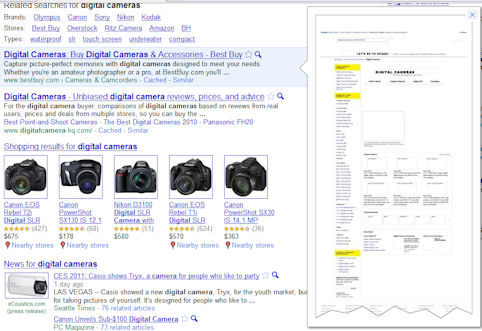Google does an awesome job in creating new signals for itself. Two recent ones have caught my attention:
- Google Preview: You can see what this looks like here:
 |
Once you enter a search result in, if you click on the magnifying glass you see a preview of the web page before you click through on it and decide to visit it. What is interesting about this is that users will need to move their cursor to the magnifying glass and click on it to see the preview. This is just as much work as it is to click through to the web page and look at it. I can’t imagine that more than a small percentage of people will do this.
So why would Google do this? To get a signal. Imagine that 3% of search queries result in someone previewing before clicking through on it. Even the fact that they felt the need to preview it represents a signal. It tells Google that the previewer did not have an immediate sense of brand recognition and wanted to check it out from a distance first. The second signal is the percentage of people who preview a listing that end up clicking on it. The key to both these signals is how your page compares to your competition for these metrics.
From Google’s perspective, this is really valuable data.
- Goo.gl: Google’s new URL shortener is pretty interesting to. Danny Sullivan did a nice analysis of how this compares to bit.ly. It does seem like a bit of a me-too service, so why would Google do this?
One thing that Google is looking actively for is data from within social media properties. Social data is already in use as a signal, and they are looking for more of it. The great thing that goo.gl can do for them is give them data on the click history to the destination page of a shortened URL. In fact, this works even if the social site is a walled garden.
Yet again, some more awesome data.
Summary
When Google makes these announcements it is always interesting to read a bit between the lines. As readers of my writings know, I believe that Google truly understands the critical nature of protecting its brand through maximizing user satisfaction. More quality signals is a big key to that, so a lot of creative energy at Google will continue to be invested in these types of initiatives.
